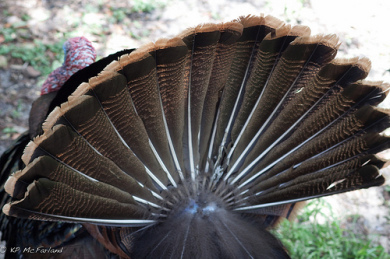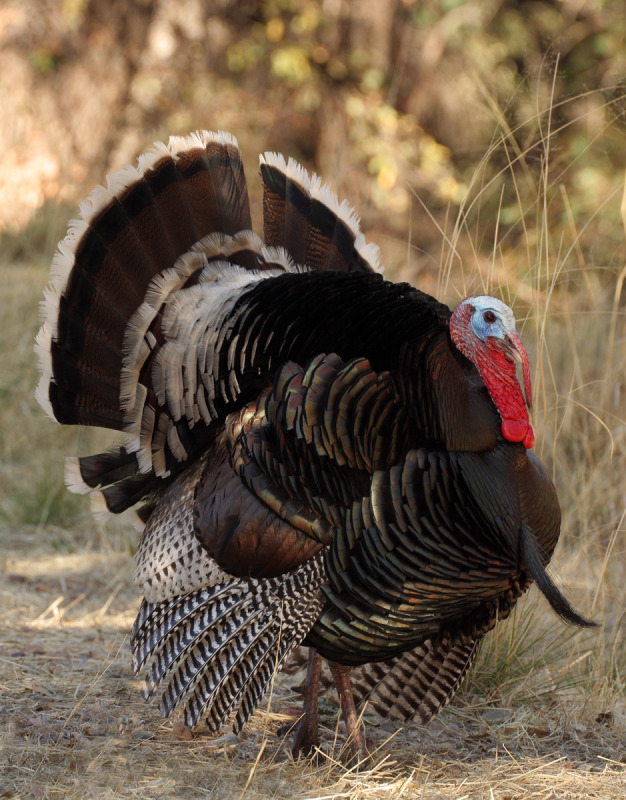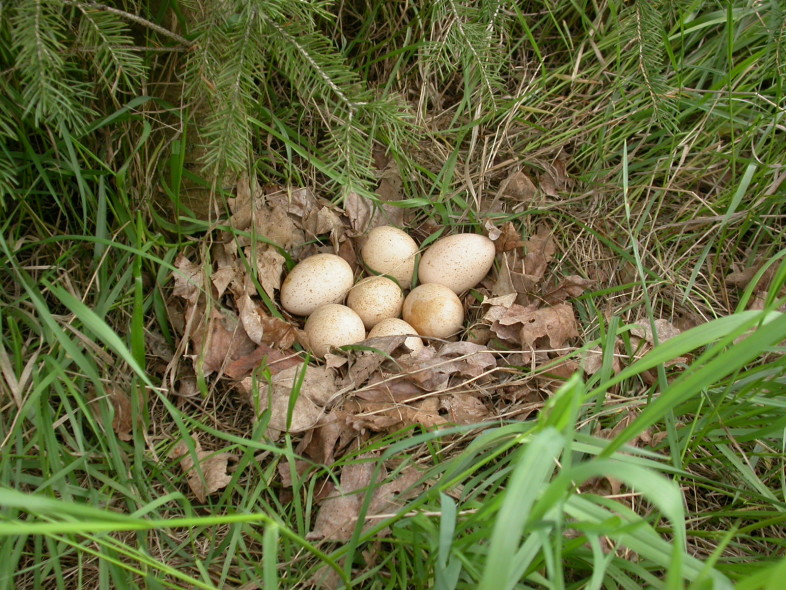Ben Franklin really did have a point when he lobbied for Wild Turkey over Bald Eagle as the national bird.
The Bald Eagle “is a bird of bad moral character, he does not get his living honestly …” Franklin once wrote, adding. “… too lazy to fish for himself, he watches the labor of the fishing-hawk [Osprey] and when that diligent bird has at length taken a fish, … the Bald Eagle pursues him and takes it away from him.”
The Wild Turkey, he wrote, is “though a little vain and silly, a bird of courage that would not hesitate to attack a grenadier of the British guards, who should presume to invade his farmyard with a red coat on.”
This week Wild Turkey is, of course, an American icon, even beyond the supper table. Our turkey is the only native North American bird to be domesticated on a worldwide scale. Chickens and Ring-necked Pheasants are non-native, but Wild Turkey is an outrageous American export.
Which brings us to the following dispatch – on snoods – from VCE Conservation Biologist Kent McFarland.
So how did you choose your turkey? By weight? Perhaps it is from a favorite farm? Or it could be a brand that you like? But if you were a female turkey, you’d be looking at the male’s snood.
The snood is a fleshy appendage that attaches just above the beak. When tom turkey is just chilling, his snood can be fairly short, but when he struts for the ladies his snood engorges with blood and hangs awkwardly off his bill. It’s a hen head-turner.
This bit of bird bling-bling would probably make Mr. Darwin smile with thoughts of sexual selection. Darwin was first to suggest that mate choice and competition for mates might be a selective pressure that shapes the evolution of populations. If this is true, why would female turkeys prefer a big snood? Is this simply a sexy ornament or is it perhaps a signal of worthiness?
Richard Buchholz, a biologist from the University of Mississippi, pondered these very questions and Wild Turkeys proved to be a perfect study animal. Males mate with multiple females (called polygyny), and the sexes look very different (sexually dimorphic). Buchholz designed some fancy mating tests, checked out the health of the males, and eureka, the answers to snood fashion were discovered.
First, Buchholz found a non-sexual function for the bare parts on the head. They are crucial for cooling down strutting tom when he is exerting himself on a hot day. Snood or no snood, he needs his radiator. So there is a clear physical reason for the bare skin. But that still doesn’t explain the long snood.
He did show that a long snood is indeed selected by females, but males also select for it. Females were attracted to a long snood and males deferred to other males with longer snoods. But what is it about a long snood? What does it signal? Healthy, wealthy or wise?

If you don’t have the long snood, show them the tail!
It turns out that the longer the snood a male has the fewer intestinal parasites he carries. Long snooded males are more resistant to parasitic infections. Buchholz suggests that if this is true, it might be a case of females choosing males with good genes. And males that are free of parasites are probably more dominant over other males. Short snooded males that defer to long snoods might be able to assess the competition before fighting with them and avoid wasting energy in fruitless fights that they are sure to lose to the healthier snood.
I hope this year you have selected a terrific snood to grace the table. Have a Happy Thanksgiving.
— — —
A few more cool facts from our colleages at the Cornell Lab of Ornithology:
- When they need to, Turkeys can swim by tucking their wings in close, spreading their tails, and kicking.
- The English name of the bird may be a holdover from early shipping routes that passed through the country of Turkey on their way to delivering the birds to European markets.
- Male Wild Turkeys provide no parental care. Newly hatched chicks follow the female, who feeds them for a few days until they learn to find food on their own. As the chicks grow, they band into groups composed of several hens and their broods. Winter groups sometimes exceed 200 turkeys.
- As Wild Turkey numbers dwindled through the early twentieth century, people began to look for ways to reintroduce this valuable game bird. Initially they tried releasing farm turkeys into the wild but those birds didn’t survive. In the 1940s, people began catching wild birds and transporting them to other areas. Such transplantations allowed Wild Turkeys to spread to all of the lower 48 states (plus Hawaii) and parts of southern Canada.
- Because of their large size, compact bones, and long-standing popularity as a dinner item, turkeys have a better known fossil record than most other birds. Turkey fossils have been unearthed across the southern United States and Mexico, some of them dating from more than 5 million years ago.



What is the history of turkey populations in Vermont? I remember as a kid the population levels were incredibly low (or so my parents mentioned). Now I can barely drive to work without running one over in the fall. What was the extent of the program which brought us their return?
Super question Jason. By the 1850s, turkeys were gone from Vermont believe it or not. In the 1950s many attempts were made at reintroductions by private individuals, but they used stock that wasn’t directly from the wild and they all failed. In the 1970s VT Fish and Wildlife got wild stock from Allegheny Mountains in NY State. The populations took off. By the 1970s there was a hunting season. After some ups and downs in the 1980s and 1990s, it is now at an all-time high of about 35,000 and has spread to all parts of the state. It is a super conservation success story that isn’t really told enough.
Fascinating! When I first came to Vermont in the early ’90s, now that I think back on it, I don’t recall seeing that many wild turkeys. But now they seem to be everywhere. What a success!
On other subjects, longer snood = less parasites? Sign me up for one!
Hmmm, so Vermont has more turkeys than Eagles???